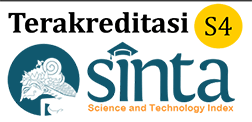Submissions
Submission Preparation Checklist
As part of the submission process, authors are required to check off their submission's compliance with all of the following items, and submissions may be returned to authors that do not adhere to these guidelines.- The submission has not been previously published, nor is it before another journal for consideration.
- The submission file is in Microsoft Word (.doc / .docx) document file format or Rich Text Format (.rtf) .
- The manuscript plagiarism index is below 20% by using IThenthicate or Turnitin
Copyright Notice
Authors submitting a manuscript confirm that the work is original, has not been published elsewhere, and is not under simultaneous consideration for publication by another journal. They also affirm that there are no conflicts of interest to disclose and that all authors have reviewed and approved the final manuscript for submission.
Upon acceptance for publication, authors transfer copyright of their article to Jurnal Ilmiah Teknologi Informasi Asia. This includes the rights to reproduce, transmit, and translate the material in any form or medium.
While the editorial board endeavors to ensure accuracy, they accept no responsibility for the content of articles or advertisements. Liability rests solely with the respective authors and advertisers.
Website material is licensed under a Creative Commons Attribution 4.0 International License (CC BY 4.0). Under this license, users are free to share and adapt the material for any purpose, including commercial use, provided license terms are met. These freedoms are irrevocable by the licensor under such conditions.
Privacy Statement
Jurnal Ilmiah Teknologi Informasi Asia is committed to protecting the privacy of its users, including authors, reviewers, editors, and readers. This privacy statement outlines how we collect, use, manage, and protect the personal information provided to us through the journal's website and editorial processes.
Collection of Personal Information:
We collect personal information when users interact with the journal site, such as during manuscript submission, peer review, registration, or subscription. This information may include:
- Contact details (name, affiliation, postal address, email address, phone number)
- Login credentials (username and password)
- Affiliation and professional details
- Research interests
- Metadata associated with submitted manuscripts
We also collect some non-personal information automatically when you visit our site, such as IP address, browser type, referring website, and pages visited. This information is used for website analytics and to improve user experience.
Use of Personal Information:
The personal information collected is used exclusively for the stated purposes of this journal, including:
- Processing and managing manuscript submissions and the peer review process.
- Communicating with authors, reviewers, and editors regarding submissions, reviews, and editorial decisions.
- Publishing accepted articles (author names, affiliations, and email addresses are made publicly available as part of the publication record).
- Managing user accounts and providing access to journal content and services.
- Improving the content and functionality of the journal website.
- Generating statistics on journal usage (aggregated and anonymized data).
- Sending important notifications and updates related to the journal (users may opt-out of non-essential communications).
- Ensuring the integrity and security of the journal and its processes.
Data Protection and Security:
We implement appropriate technical and organizational measures to protect personal information from unauthorized access, disclosure, alteration, and destruction. Access to personal data is restricted to authorized editorial staff and technical personnel who require the information to perform their duties.
Disclosure to Third Parties:
The names and email addresses entered in this journal site will be used exclusively for the stated purposes of this journal and will not be made available for any other purpose or to any other party without your explicit consent, unless required by law. However, certain information, such as author names and affiliations, will be published alongside the article.
We may use third-party services to support journal operations (e.g., indexing databases, plagiarism checking). In such cases, personal information will only be shared to the extent necessary for these services to function and in compliance with this privacy policy and applicable data protection laws.
Confidentiality of Manuscripts:
All manuscripts submitted to the journal are treated as confidential documents. Editors and reviewers are required to maintain the confidentiality of the content of submitted manuscripts and not disclose any information about a manuscript to anyone other than the corresponding author, reviewers, potential reviewers, and the publisher, as appropriate.
User Rights:
Individuals have the right to access, update, correct, or request the deletion of their personal information held by the journal. Requests regarding personal data should be directed to the journal's editorial office.
Changes to this Privacy Statement:
This privacy statement may be updated periodically to reflect changes in our practices or legal requirements. The latest version will always be posted on the journal's website.
By using this journal site, you consent to the terms of this privacy statement.









